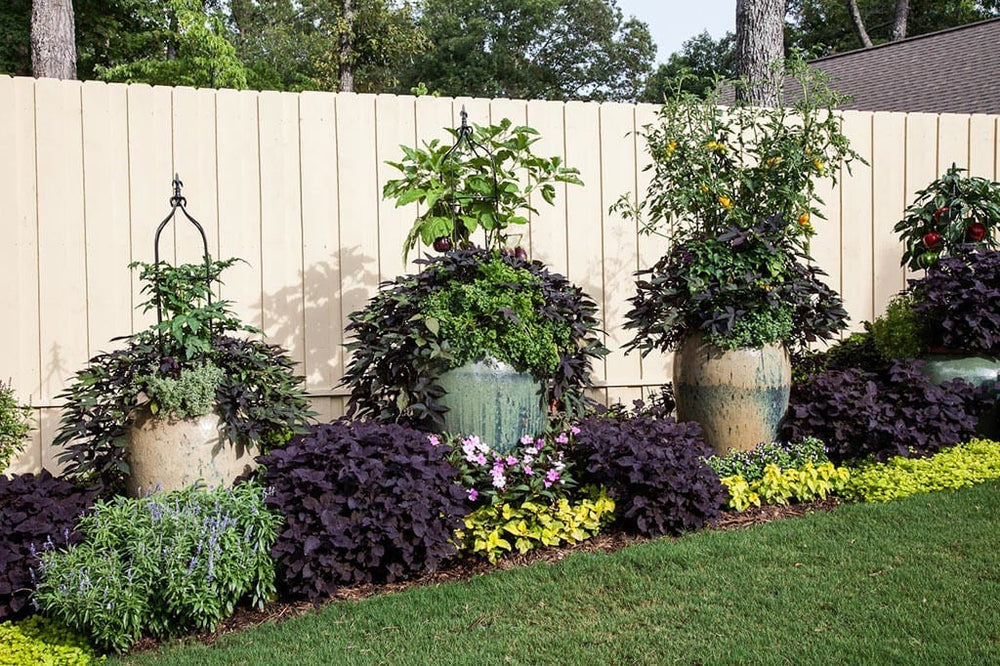It doesn't get any fresher (or more local) than having sun-warmed vegetables and flavorful herbs growing just steps away from the kitchen. And while starting your edible container garden can be as simple as putting a plant in a pot, why not create something that adds flair as well as flavor? Here are some edible container design tips to get you started. For unity, work with just one pot style per area, and add interest by varying heights, detailing, or tones. For strong growth, a big harvest, and beautiful blooms, be sure to fill containers with Miracle-Gro® Potting Mixand feed plants regularly with Miracle-Gro® Shake ‘n Feed® All Purpose Plant Food, which will deliver just the right nutrition to veggies, herbs, and flowers. Master the following three displays, and you will be able to create all sorts of winning combinations, no matter how large or small the space.
One hit wonder
If you have only one pot to work with, make it your focal point. Opt for a container that is large, has exceptional detail, a colorful glaze, or is a pedestal urn.
Perfect pair
Symmetrical balance works beautifully with traditional architecture, and is a wise choice for a formal-looking garden. When one pot on either side of an entry or structure gets lost because the space is large, pair two pots together (a large and small) on either side. This works especially well on steps.
Three's company
Asymmetrical balance can work in both formal and informal settings. When working in threes, it is important to vary heights first and diameters second. Group the pots in a triangle so that the tallest is in the back. If flanking a door or creating a divided trio on a patio, place the biggest pot to one side and balance with the two smaller pots, pushed close together, a few feet away.Working with the above concepts, you now have a limitless range of options. Here are a few more ideas to consider:
- Repeat one fabulous pot planted the same way to create unity in a border.
- Echo pairs or groups of pairs around a pool or terrace.
- Cluster three or five pots in a group and place on the corners of a deck or patio, at the end of a walk, sunk into deep borders, or gathered alongside the end of a driveway.
One classic, no-fail container combo to try consists of planting a thriller (something tall or spikey, like a determinate tomato or artichoke), a filler (something shorter to fill the space around the centerpiece, like basil or parsley, or pansies), and a spiller (something to cascade over the edge of the pot, like thyme).
Another option is to create a design using just two plants. There are two ways to do this:
- Back load, where the larger growing plant is positioned near the back of the pot and the smaller plant is in front. Think Swiss chard fronted with violas or stevia fronted with spearmint.
- Center load, where the larger plant is centered in the pot and the shorter plants surround it. Try this with a topiary-form rosemary or bay, and surround with sage or thyme. This would also work with a trellised tomato, surrounded by marigolds or oregano.
Be a collector
If you're just starting out, select a style that complements your architecture and stick with it. Vary heights, detailing, and tone for interest. Love blue glazed pots? Make them your signature. Traditionalist? You can never go wrong with rolled rims. When you collect, everything matches no matter where you put it.Now that you have some ideas for the plants in your container garden, it's time to talk about the containers themselves. Try these simple tricks when selecting pots for your plants:
- Match the surface. For a seamless look, select a pot color similar to the surface color it will be sitting on. Or, paint pots to match the trim of your house.
- Hang around. Large coir-lined metal baskets make great planters. As much as we love them, pansies and petunias aren't the only annuals that thrive in a hanging basket. Try yours with strawberries, lettuces, patio tomatoes, or even pickling cucumbers.
Article written by Rebecca Reed.







 Herbs
Herbs
 Vegetables
Vegetables
 Fruit
Fruit
 Flowers
Flowers
 Succulents
Succulents


